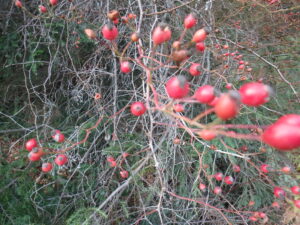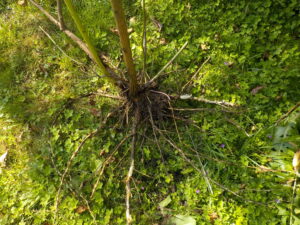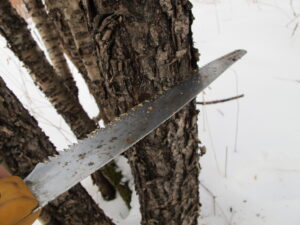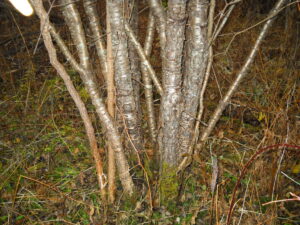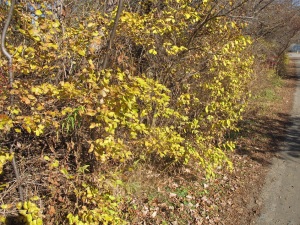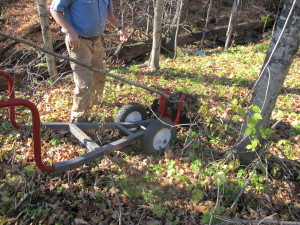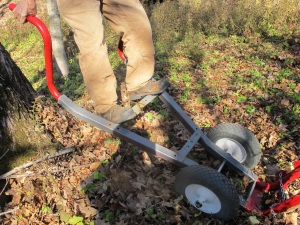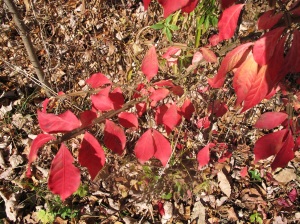Invasives: What are they? What can you do about them?
Multiflora roses just showed up on my property last year, probably by birds that dropped seeds. It is easy to see roses growing in your woods or fields, or even in a garden bed and pass it by as “just a rose”. But the roses we love don’t just appear.
First, I dress appropriately: jeans, long-sleeved shirt, a hat with a brim, and heavy winter leather work gloves. This culprit wants to hurt anyone trying to uproot it. I cut off the branches, just leaving a foot or so to grab onto when pulling it out. Then I loosen the soil and pull weeds around it. The roots radiate outward from the stem like spokes on a bike. I loosen each root and tug gently when they are small enough to remove.
I’ve read that just cutting back the stems to ground level will stimulate the roots to send up new shoots everywhere, causing a bigger problem. There is no easy answer. Invasive plants are always difficult to remove – usually a scrap of root can generate a new plant – or several.
Since buckthorn are often multi-stemmed, it can be difficult to use that method. Do it up high enough that you can get your saw in between the stems. But I’ve done it, and it works.
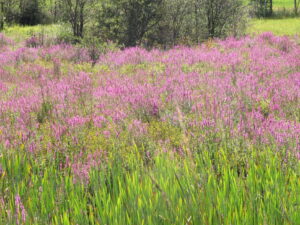 As regular readers of this column k now, I only use organic techniques in the garden. This means no chemicals including herbicides. From what I have read, most herbicides will not kill the invasives mentioned in this article. They will set them back considerably, depending on the age of the plant and the dose of the chemical. But learning to recognize all the invasives is best. And if one appears on your landscape, get rid of it immediately! And remember, persistence is important
As regular readers of this column k now, I only use organic techniques in the garden. This means no chemicals including herbicides. From what I have read, most herbicides will not kill the invasives mentioned in this article. They will set them back considerably, depending on the age of the plant and the dose of the chemical. But learning to recognize all the invasives is best. And if one appears on your landscape, get rid of it immediately! And remember, persistence is importantInvasive Plants
Going for a walk the other day along a public trail I was struck by the number of invasive shrubs I saw. Most trees and shrubs have shed their leaves, but burning bush (Euonymus alatus), Japanese barberry (Berberis thunbergii) and honeysuckle (Lonicera spp.) still have leaves on their branches. Holding leaves and producing food by photosynthesis gives them extra energy to take over the world (or their world, anyway). This is a good time to pull a few of these out because many are very visible right now.
Why bother, you might ask? Because these invasive plants which come from the China or Japan have no natural enemies here. Left alone, they can take over the landscape, outcompeting our native wildflowers and understory shrubs, although that may take decades. In some places they have created monocultures by elbowing out other plants. Most birds, mammals and insects have evolved while depending on native species for their food and shelter. Do these shrubs provide food? Yes, but it is often not of the same quality as that of our native species.
Cutting down invasive shrubs will not necessarily kill them. Some invasive trees and shrubs react by sending up multiple new shoots from their roots. Instead of one buckthorn, for example, you suddenly have several in a circle around the tree you cut down. That increases the problem instead of solving it.
I have found that buckthorns can be killed without producing the root suckers if I double girdle the tree. By this I mean I cut a ring around the tree with a pruning saw, and then cut another ring a foot higher or lower than the first cut. I cut through the bark and the green cambium layer, but do not cut into the heartwood. If I do this now, the tree will leaf out next spring and the following spring, but slowly die by the third year. Patience is the key. The technique allows you to slowly starve the roots – they can’t get any nutrition from the leaves. Many buckthorns have multiple stems, and you must girdle every one to kill the roots.
For small to medium sized invasive trees and shrubs, pulling them up is another option. I recently met with Gerry Hawkes, an inventor and forester in Woodstock, Vermont to try out a tool he developed to pull invasives (and do other tasks such as hauling firewood and moving large stones). It is a sturdy, 2-wheeled device that uses leverage to pull up a tree, roots and all. We pulled an inch-and-a-half buckthorn tree and a full size multi-stemmed honeysuckle with a trunk that was over three inches in diameter at the base.
The tool we used is called a Wheeled Post and Shrub Puller (http://
We looped a light chain around the base of the tree and then attached it to one of four notches on the puller to allow us to begin with the best mechanical advantage, which is 12:1. I pulled down on the handle using my weight and it lifted the buckthorn partially out of the ground. Then, to get an even higher lift, we reset the chain to a different notch on the front of the tool and I got the root system right out of the ground! Since this tool is on 16 inch wheels, I was able to roll the tree away with little effort.
I have also used a hand tool called a Weed Wrench that pulls small trees and shrubs. Unfortunately, the company that makes these tools has gone out of business. It was made in four sizes with a gripping mouth-part that clamps down on a trunk, and a handle that uses leverage to pry out shrubs. Two other companies are now marketing similar tools, The Uprooter (www.theuprooter.com) and the Pullerbear (www.pullerbear.com). From what I have read, neither would compete with the tool I tried last week for pulling larger shrubs and small trees.
I think that using mechanical advantage to pull invasives makes much more sense than using chemical herbicides. But I don’t have personal experience following up over several years with invasives pulled: will the scraps of roots left in the ground survive and re-sprout? It’s possible that they will. Still, I think that Conservation Commissions and Garden Clubs would be well served by investing in pulling devices to share with interested townspeople and using along public pathways.
There are no plant police. No one can tell you that your invasive shrubs must be pulled up. Nurseries may not sell them, propagate them or transport them. But I am working hard at removing mine. And even if you live in a city, it makes sense to remove invasive plants on your property. Their seeds may wash down storm drains, and end up in a wetland or river – and spread their genetic material.
Getting rid of invasive plants takes time. I recently chatted with a woman who removed all the burning bush on her property 12 years ago. She is still pulling seedlings that germinate from seeds deposited over a decade ago. But, on the positive side, pulling “thugs” gives you more room to plant other nice landscape plants. So go look for invasive plants now, and try to get rid of a few.
Henry Homeyer is a gardening consultant and coach. He speaks to garden clubs and civic organizations about many aspects of gardening. Contact him at henry.homeyer@comcast.net or visit his website, www.Gardening-Guy.com.



